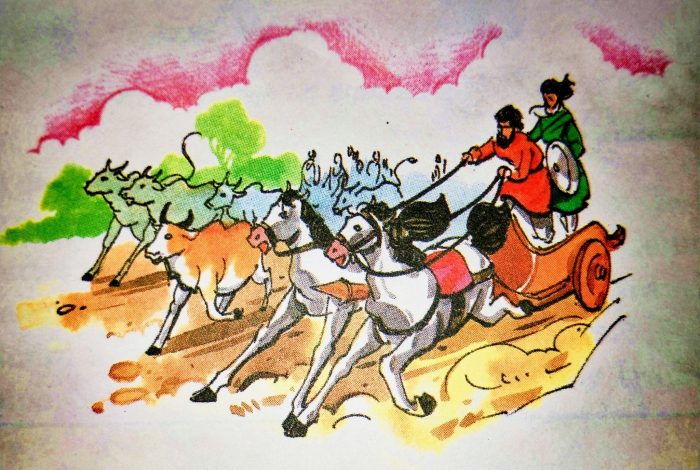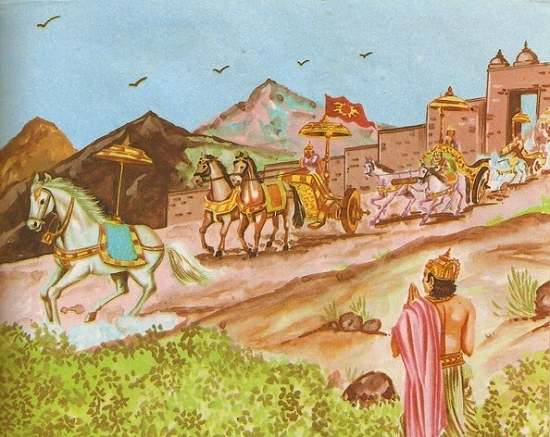

In Ancient times the battles between two clans were fought for resources like pasture, water and cattle. Men participated in all wars and there was no regular army. Some parts of the exploits were taken by the leader and some were donated to priests and the rest were distributed among people. The leader used to make big sacrifices in Yajna and claim his right over the land. Earlier rajas were different from later rajas. They did not have their capital or armies and they did not collect taxes. Some rajas were chosen by the Janas or People, but around 3000 years later, there was a change in the way in which rajas were chosen.

Ancient Rajas in Battles
रोहित साव27, CC BY-SA 4.0
In Ancient times sometimes the leader of any clan or village was chosen by the Janas or people. Later, around 3000 years ago there were some changes came in choosing the rajas.
The position of Raja was not hereditary; it was earned through sacrifices in Yajna.
Men got the position of Raja by accomplishing big sacrifices.
The most famous ritual was the Ashvamedha or horse sacrifice.
In the Ashvamedha ritual, a horse was set loose to wander freely; it was protected by the king’s guards.
If that horse entered another king’s territory and if it was stopped or captured, then that king had to fight with the Raja.
If the other king did not cease the horse, it meant that he had accepted the suzerainty of another king.
Then kings were invited to sacrifices organised by another Raja, and the raja who organised the sacrifice was recognised as powerful.
Those who came to sacrifice brought gifts for the raja.
The priests who performed the rituals were highly trained and were handsomely rewarded.

Asvamedha Yajna
रोहित साव27, CC BY-SA 4.0
The king held the central position in the administration.
He was the organiser of big and lavish sacrifices.
He used big sacrifices and Yajna to strengthen his place and increase his power.
Raja used to go to war for the land, pasture and cattle. The exploits of war were distributed among the people, and raja kept some portion for himself.
Raja was the centre figure of rituals organised by him, he used to sit on his throne and his charioteer used to chant tales of his glory on the battlefield.
The wives and sons of raja had some minor rituals in sacrifice.
The other rajas were spectators of these rituals; they had to sit and watch the rituals and they brought gifts.
Priests chanted holy verses and performed multiple rituals during the Yajna. The priests sprinkled holy water on the king during the ritual.
The Common people, the Vish or Vaishyas also brought gifts for kings and they were allowed to watch the rituals.
The Sudras were considered low caste and they were not allowed to see the sacrifice.
Janpadas were the early kingdoms which were generally Monarchial in nature and some of the Janpadas were republics.
Janpada simply means a place where Jana puts his feet, it means that it was the place where people resided.
The period of Janpadas is between 1500BC to 600 BC.
The Rajas who made big sacrifices in Yajna came to be recognised as rajas of Janpada rather than Jana.
There were many Janpadars in ancient India, such as Hastinapur and Atranjikjera.
People of Janpadas lived in huts and kept cattle, and they grew crops like rice, barley, wheat, pulses and sugarcanes.
They used painted grey wares as pots.
Around 2000 years ago, some Janapada developed more than others and became Mahajanpadas.
Most Janpadas had Capital and Kings of Janpadas had built strong walls around their forts to prevent any attack from other kings and keep their subjects safe.
Rulers used a vast wealth on building walls and forts, and the people used to live inside the walls of the capital city.
The new rajas had their standing armies, and the soldiers were paid a regular salary in cash.
The king issued their punch-marked coins.
The two main duties and roles of the kings of Mahajanpadas were; building huge forts and maintaining huge armies.
Rajas of Mahajanpadas started taking taxes because maintaining a huge army and building forts needed resources.
The taxes were fixed at 1/6 of the total produce. This was named Bhaga.
There were taxes in the form of labour also, the craftsman had to work for the king, for one day every month.
Herders and hunters had to give some portion of their products to Raja.
The ancient rajas were different from the later kings, they did not have a capital or an army. people used to go to war with the king and they were given the exploits of war. They used to go to battles for pasture, lands and cattle. Rajas kept a portion of exploits of war and used to make big sacrifices to gods in the Yajna. The Yajna was organised by rajas and well-trained priests performed the Yajnas. Raja gave vast rewards to the priests and also received many gifts from other smaller rajas.
Q1. What were the two duties of rajas in Mahajanpadas?
Ans. The two main duties of Rajas in Mahajanpadas were −
Building strong Forts and walls of the capital.
Form a strong standing army.
Q2. How men became Raja Janpadas?
Ans. The men gained the position of raja by doing vast sacrifices in the Yajna. The rajas used to organise Ashvamedha Yajna and declare their power to other kingdoms.
Q3. What was Ashvamedha's sacrifice?
Ans. Ashvamedha sacrifice was a practice performed by rajas in the Yajna. A royal horse was let loose to roam freely and wherever the horse went that area would come under the rule of the king. If any other king stopped the horse he had to fight with that king.
Q4. Why did the rajas built forts?
Ans. The rajas of Mahajanpadas build forts and fortifies their capital to gain control of their people because it was easy to rule people in a fixed place. The other reason was to keep the city safe from the attack of another kingdom.
Q5. What was the role of raja in sacrifice?
Ans. The raja was the centre of sacrifice, he was given his special seat and he used to watch the priests performing the sacrifice, the relatives of the raja had also some minor rituals to do.